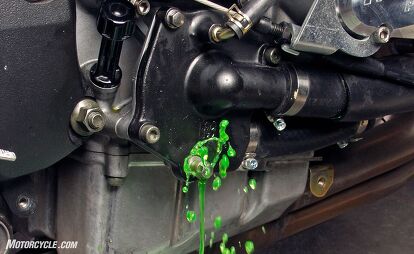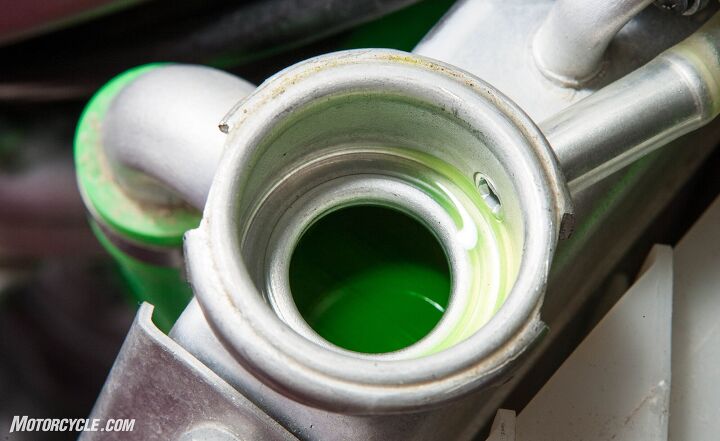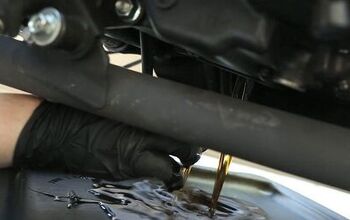MO Wrenching: How Do I Change My Coolant?

So easy, even a MOron can do it
We recently covered how to check to see if your coolant is in good enough condition to protect your bike during its winter hibernation. Even if your coolant can handle the temperatures of winter, most manufacturers have a recommended service interval of two years or so between coolant swaps.
MO Wrenching: How Do I Check My Coolant?
Since changing coolant is a relatively simple task, it is an ideal maintenance chore to help a newbie mechanic gain confidence. Make sure the engine is cold and place your bike on a rear stand. If you don’t have one, the sidestand will usually be fine. Remove any lower bodywork that could get splashed during the process. The same goes for bodywork around the radiator filler.
Locate the drain plug. (It’s usually on the water pump cover.) Place a container, large enough to hold all the coolant, under the plug. Wear latex gloves to keep the antifreeze off your skin. Open the filler cap at the top of the system. Using a wrench, unscrew the plug. Before the plug is completely out, the coolant will start to leak past the threads. So, be prepared. Don’t immediately pull the plug free and let the system drain, though. Let it drain down a bit or you risk having the engine pee over the pan onto your garage floor. (Don’t ask how I know this.)
As soon as the system is completely empty, reinstall the plug and a fresh copper washer and torque to specs. Next, empty the expansion tank into the catch pan. Pour the used antifreeze into a suitable container for transporting it to a recycling center or auto parts store. For some reason, children and pets have a fatal attraction for this extremely toxic liquid, so get it sealed up and out of reach quickly.
Those who will be filling their cooling systems with a 50/50 mix of coolant and distilled water should mix the solution prior to pouring it into the filler. That way you’re certain about the mixture no matter how much liquid the system requires. Also, you’ll have a container of the proper mixture if you need to top off the expansion tank in the future. Because I’m lazy, I usually buy premixed coolant and avoid having to mix my own.
Note for track riders required to run without glycol-based anti-freeze: Buy a bottle of Red Line Water Wetter. The bare aluminum inside the engine will be protected from the corrosive properties of the water, and the system will cool more efficiently. In fact, many performance-minded riders put Water Wetter in systems running ordinary coolant for that very reason. Also, if you truly care about the condition of your engine, only use distilled water. Tap water will have varying levels of minerals (depending on the community) that can create deposits on the engine internals.
Once you’ve filled the cooling system to the brim, you need to run the engine with the filler cap off. As the engine warms up, you’ll see bubbles working their way out of the system. In fact, as the engine circulates the coolant, you may see the level drop quite a ways. Keep topping off the system as the level drops. When the engine starts to warm up, the coolant will start to expand out of the filler. Stop the engine and replace the radiator cap. Fill the expansion tank until the level is midway between the two lines. Now, take your bike for a short ride to get it completely up to temperature, then park the bike and allow it to cool off completely. Top off the cooling system and button up your bodywork.
[This article was adapted from Evans Brasfield’s book 101 Sportbike Performance Projects. Learn more about it here. Read the MO review here.]

Like most of the best happenings in his life, Evans stumbled into his motojournalism career. While on his way to a planned life in academia, he applied for a job at a motorcycle magazine, thinking he’d get the opportunity to write some freelance articles. Instead, he was offered a full-time job in which he discovered he could actually get paid to ride other people’s motorcycles – and he’s never looked back. Over the 25 years he’s been in the motorcycle industry, Evans has written two books, 101 Sportbike Performance Projects and How to Modify Your Metric Cruiser, and has ridden just about every production motorcycle manufactured. Evans has a deep love of motorcycles and believes they are a force for good in the world.
More by Evans Brasfield





































Comments
Join the conversation
i think there are two types designated 3.0 and 5.0;
2017 ktm 250/300 require 3.0.
The divorce from my bohemian uncle permanently changed my cool aunt.